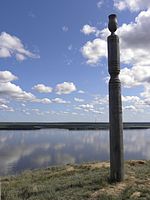Serge (religious)
This article needs additional citations for verification. (January 2021) |

A serge (Buryat for "pole") is a ritual pole or tree at the Buryats and Yakuts.[1] The serge is placed to indicate that the place in question has an owner. For example, a serge stands as a pole at the entrance to a yurt or at the gate of a house to indicate that as long as the serge is there, the family will live there. Traditionally, a serge cannot be destroyed, but can only decay.
The serge is connected to the horse cult, as both the hosts and the guests tied their horses to it. It is also a symbol of the world tree that unites the three worlds: Three horizontal grooves are cut on the pole, the upper one intended to bind the horses of the heavenly inhabitants of the upper world, the middle one intended for the horses of men, and the lower one for the horses of the underworld.
In the past, serges were placed at every yurt and also at the initiation of the shaman (the shanar-rite). At the cemeteries of the shamans very high serges were placed for the unification of gods and spirits. Serges in the form of stone obelisks were also placed on these cemeteries (deer stones). The most famous of these stones is the Altan-Serge ("golden pole"), is located in the Tamchinsky datsan in the Buryat village Gusinoye Ozero.
Gallery[]
Serge at Staraya Tabaga at the Lena river
Serges in 'Gesera' camp on a mountain pass of the mountains in Buryatia

A series of serges at Shamanka on the Olkhon Island in Lake Baikal
See also[]
- Ceremonial pole
- Inuksuk, manmade stone landmark or cairn in Inuit cultures
- Totem pole, manmade wooden landmark or cairn in the Northwest coast
- Asherah pole, sacred tree or pole in ancient Canaanite religion
| Wikimedia Commons has media related to Serge. |
References[]
- ^ Гончаров, Alexey Goncharov // Алексей. "Памятник Якутии". www.unmonument.ru.
- Buryat culture
- Yakut culture
- Wooden sculptures
- Types of monuments and memorials


